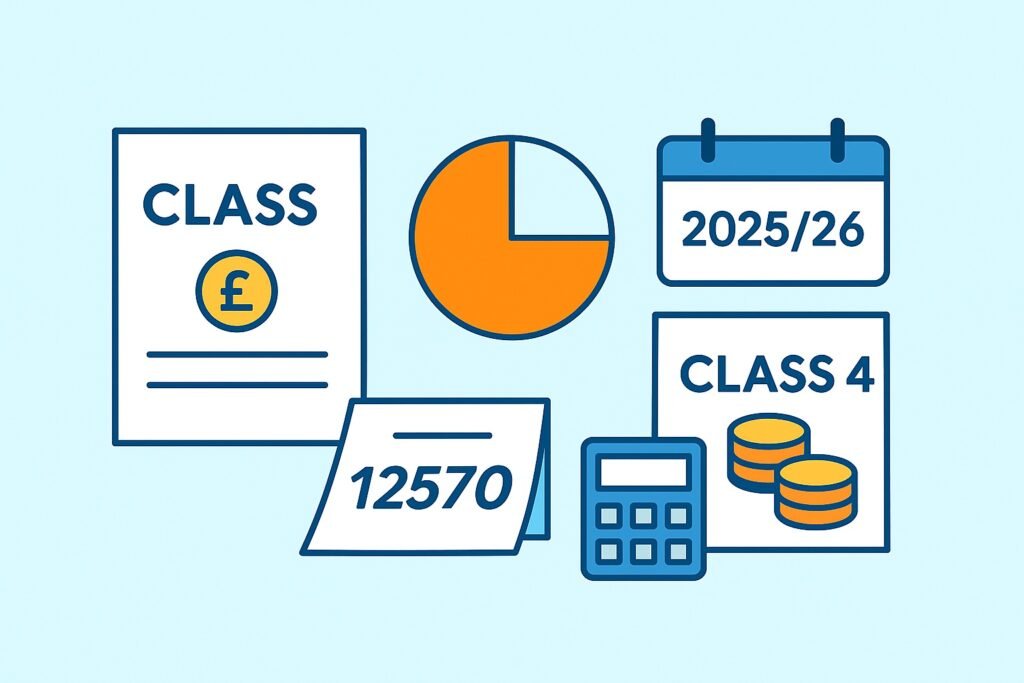
National insurance (NI) is a deduction from earnings, originally set up to fund various state benefits such as the NHS and the state pension.
In reality, NI is just another form of income tax in all but name.
In this guide, we explain how the NI system works, and what rates you pay as a sole trader – and how it differs from being an employee or a limited company director.
We have updated this guide for the 2025/26 tax year
National Insurance – different classes
There are several types of NICs, depending on your working status:
- Class 1 NICs – Paid by employees and employers via PAYE. Limited company directors also pay this on their salaries.
- Class 1A NICs – Paid by employers on benefits-in-kind, e.g. company cars or private medical cover.
- Class 2 NICs – Flat-rate contributions for the self-employed. Since April 2024, these are voluntary unless your profits are below the Small Profits Threshold.
- Class 3 NICs – Voluntary contributions you can make to fill gaps in your NI record to maintain your State Pension entitlement.
- Class 4 NICs – Paid by the self-employed based on their annual taxable profits, paid via self assessment.
NI for sole traders in 2025/26
If you’re self-employed (i.e. a sole trader or in a business partnership), the following rates apply for the 2025/26:
- Class 4 NICs: 6% on profits between £12,570 and £50,270, and 2% on profits above £50,270
- Class 2 NICs: £3.50 per week, paid voluntarily if profits are under £6,845 to protect your NI record
Profits above £6,845 automatically entitle you to a State Pension qualifying year. If you earn less, voluntary Class 2 NICs can help preserve your contribution history. Class 2 NICs are far cheaper than Class 3, which costs £17.45 per week in 2025/26.
What’s changed with Class 2 National Insurance?
From April 2024, Class 2 National Insurance is no longer compulsory for most self-employed people.
If your annual profits are above the Small Profits Threshold (£6,845 in 2025/26), you’ll still get a qualifying year for State Pension – but you no longer have to pay the weekly Class 2 rate.
If your profits fall below £6,845, you can choose to pay voluntary Class 2 NICs (£3.50 per week) to protect your National Insurance record.
The government announced this reform in the 2023 Autumn Statement, aiming to simplify the system for low-earning sole traders. You’ll still report your decision to pay Class 2 voluntarily through the Self Assessment process.
Check the official thresholds and complete guidance on GOV.UK: National Insurance rates
NI for limited company directors (overview)
If you run a limited company, you are both a director and an employee. You only pay NI on salary, not on dividends. The company also pays employer NICs on salaries paid above the secondary threshold.
- Employee (Class 1): 8% on earnings between £12,570 and £50,270, then 2% on earnings above this
- Employer (Class 1): 15% on salaries above £5,000 per employee
- Employment Allowance: Reduces employer NICs by up to £10,500 per year, if eligible (not available to sole director companies)
For more information, read our guide to limited company taxes.
How to pay your National Insurance
If you’re self-employed
Your NICs are calculated and paid as part of your annual Self Assessment tax return. Class 4 NICs are calculated on your profits and are due by 31 January following the end of the tax year.
If you choose to pay voluntary Class 2 NICs, they are included in the same payment.
If you’re employed
Class 1 NICs are deducted automatically via payroll and paid to HMRC by your employer.
Smaller employers may be allowed to pay their PAYE and NICs liabilities quarterly if the total due is below £1,500 per month.
What if you’re both self-employed and employed?
If you earn income from both employment and self-employment, each income stream is assessed separately:
- Your employer deducts Class 1 NICs from your wages through PAYE
- You pay Class 2 and Class 4 NICs on your business profits through Self Assessment
HMRC will consider your total NICs across all income and apply a cap if necessary to avoid excessive contributions.
Do I need to pay voluntary contributions?
If your annual profits are under £6,845, no NICs are due. However, unless you pay voluntary Class 2 contributions, you won’t earn a qualifying year towards your State Pension.
Class 3 contributions are another option, but they cost around five times as much. It is usually more cost-effective to pay Class 2 voluntarily if you’re eligible.
Final notes
- NI for sole traders is based on profit, not turnover
- NICs are paid via the Self Assessment system alongside income tax
- There’s no monthly payment option for self-employed NICs – all liabilities are settled annually
FAQs
How do I check if I’ve paid enough NICs for a qualifying year?
You can check your National Insurance record online: Check your NI record
Can I get a refund if I overpay NICs?
Yes. If HMRC calculates that you’ve exceeded the annual NI maximum (for example, due to mixed income sources), they will issue a refund automatically or invite you to claim one.
What counts as profit for Class 4 NICs?
It’s your total income from self-employment minus allowable business expenses. Capital allowances may also reduce your taxable profit.
Are pension contributions deductible before calculating Class 4 NICs?
No. Pension contributions are deducted after NICs are calculated, so they reduce your income tax liability but not your Class 4 NICs.
Can I defer paying NICs if I’m struggling financially?
There is no automatic deferral for sole traders. However, if you cannot pay your tax and NICs on time, you can apply to HMRC for a Time to Pay arrangement. This may allow you to spread your liability over monthly instalments.
Can I stop paying NICs when I reach State Pension age?
Yes. You no longer need to pay Class 2 or Class 4 NICs after the start of the tax year following your State Pension age. You must still file a return if required, but your NI liability will be zero.
Why was Class 2 National Insurance abolished?
The government abolished mandatory Class 2 National Insurance from April 2024 for most self-employed people. The aim was to simplify the tax system and reduce administrative burdens, especially for those with lower profits. If your profits are above the Small Profits Threshold, you now get a qualifying year for State Pension without needing to pay Class 2 NICs.



